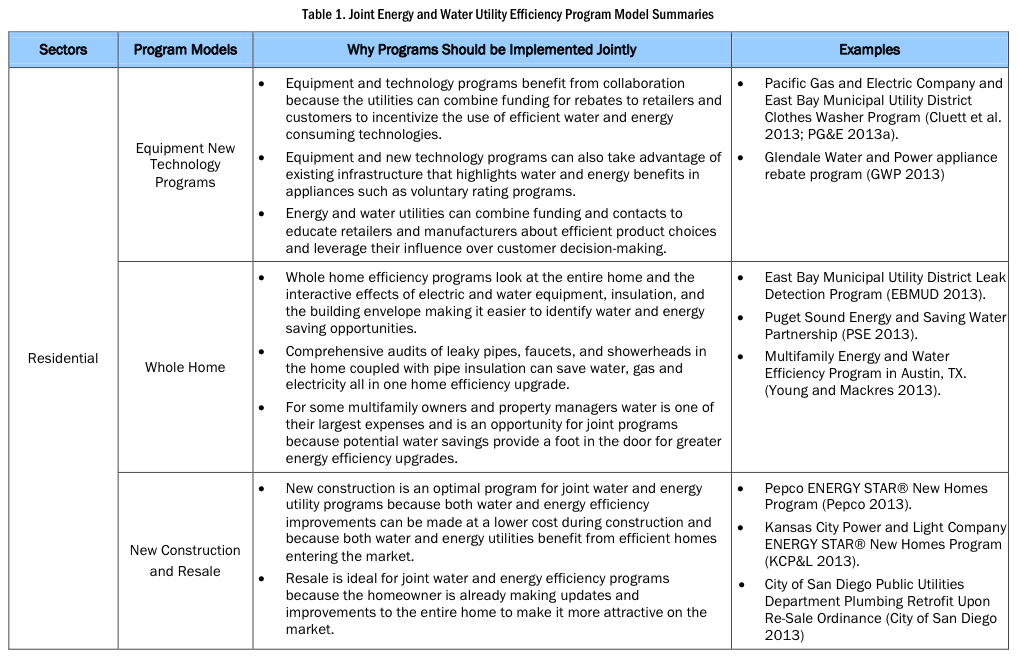AMERICAN COUNCIL FOR AN ENERGY-EFFICIENT ECONOMY
by Rachel Young
Introduction
Water and energy are inherently linked, intersecting at both the supply side (electric generation and water/wastewater facilities) and the end-use side (residential, commercial, industrial, and agriculture sectors). This intersection is commonly called the “energy-water nexus.” On the supply side, this intersection is apparent in the massive amounts of water needed to produce and deliver electricity. Coal, nuclear, and solar thermal energy generation are water intensive. Water is needed to create steam and to power turbines, but most of the water is withdrawn for cooling and then either lost in the process or discharged back into the environment. Conversely it also takes immense amounts of energy to clean and transport water. Water and wastewater utilities consume large amounts of energy to treat water—often running pumps, motors, and building equipment 24 hours a day, 7 days a week. On the end-use side, energy and water are connected in our homes, businesses, and industrial facilities.
The water-energy linkage means that efficiency programs operated by a water utility will benefit an energy utility and vice versa. Energy efficiency is a cost-effective way to reduce water use in the power sector and improvements to water efficiency can reduce energy use by water and wastewater utilities. Since efficiency decreases the demand for energy it also reduces the need to generate electricity and consume water for that generation. In addition, end-use water efficiency reduces the energy demand to treat and transport water from the water/waste water facilities into people’s homes. If utilities recognize this intersection and work together on joint programs they could learn from one another, document their savings, share costs, and potentially achieve greater savings.
Water and electric utilities differ greatly in size, number, business structure, and the regulatory environment they operate in, all of which play a role in how they can create effective joint programs. Ninety percent of water customers are served by publicly-owned and operated servers (EPA 2012b) while about 70% of electric customers are serviced by investor-owned utilities (IOU) (EIA 2013). In addition, water utilities are generally smaller and they serve smaller geographic areas compared to energy service territories, meaning there are a far greater number of water utilities than energy utilities (EPA 2012a). These differences can be challenging for joint electric and water utility-run end-use efficiency programs and in some cases joint programs may not be the best option.
Several studies have compiled some of the most prominent barriers to joint water and energy utility water and energy efficiency programs. A recent report from California Public Utility Commission staff identified some barriers within evaluation of embedded energy metrics (White and Zafar 2013) and the Pacific Institute recently published a survey of water and energy managers in California to better understand barriers to coordination (Cooley and Donnelly 2013). The Pacific Institute outlined the top ten most significant barriers to coordination between water and energy utilities in California, in order of what survey participants found to be the greatest barrier. The barriers they found are listed on the next page:
1. The water sector has limited or inconsistent funding available for combined programs.
2. Limited staff time.
3. Insufficient guidance about how to equitably allocate costs and benefits among project partners.
4. Water-related pricing policies.
5. Lack of established relationship among potential partners.
6. Insufficient guidance on how to quantify water, energy, and cost savings.
7. Inability to share customer data/customer privacy concerns.
8. Significant temporal and spatial variability in determining water, energy, and cost savings.
9. Too much emphasis on getting perfect information before starting the programs.
10. Energy sector has limited or inconsistent funding available for combined programs
(Cooley and Donnelly 2013).
Despite these barriers, collaboration between water and electric utilities can be powerful in that both utilities can explore efficiency opportunities that may not have been cost-effective or feasible absent a joint effort. In addition, profiled in ACEEE’s recent report (Young and Mackres 2013) and the Pacific Institute’s report (Cooley and Donnelly 2013) are examples of joint programs that were able to overcome these barriers. Below we discuss some of the many benefits of joint water and energy utility run efficiency programs.
Read full report (PDF) here: Saving Water and Energy Together
About The American Council for an Energy-Efficient Economy (ACEEE)
aceee.org
“The American Council for an Energy-Efficient Economy (ACEEE), a nonprofit, 501(c)(3) organization, acts as a catalyst to advance energy efficiency policies, programs, technologies, investments, and behaviors. We believe that the United States can harness the full potential of energy efficiency to achieve greater economic prosperity, energy security, and environmental protection for all its people.”
Tags: ACEEE, buildings, commercial, residential, Saving Water and Energy Together







 RSS Feed
RSS Feed